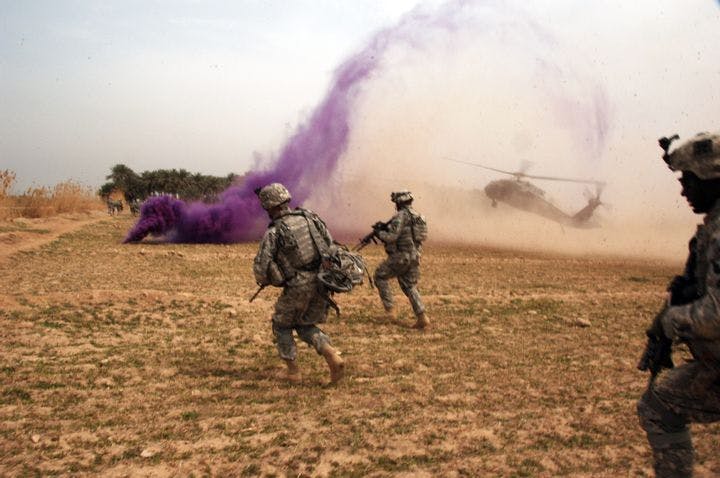Winter 2011
Masters of Peace
– James Gibney
Nathan Hodge sets out to explain how and why the Pentagon embraced the once-dreaded business of nation-building, and the "tectonic shift" that this new mission portends for American foreign policy.
In the first 11 months of its Iraq deployment, the Fourth Infantry Division’s Third Brigade Combat Team spent $72 million on public works projects in just one Baghdad suburb. That’s roughly equivalent to one year of U.S. foreign aid to the entire country of Botswana, but merely a rounding error in the U.S. military’s massive outlay of development dollars in Iraq and Afghanistan. In Armed Humanitarians, freelance defense correspondent Nathan Hodge sets out to explain how and why the Pentagon embraced the once-dreaded business of nation-building, and the “tectonic shift” that this new mission portends for American foreign policy. Hint: It’s not good news.
During the late 1990s, Pentagon theorists such as Thomas Barnett called for the military to develop its ability to cope with “gap” states—those that were not plugged into the world economy, and were therefore more prone to wars and humanitarian crises. The tremendous resources available to the military’s regional commanders had already given them de facto control over U.S. policy in many global hot spots. It took the exigencies of 21st-century conflict, however, to overcome the military’s reluctance to make school building, road fixing, and power generating a part of war fighting. Confronted in Afghanistan and Iraq by the absence or collapse of any functioning state, blooming insurgencies, and a State Department and U.S. Agency for International Development (USAID) unable and unwilling to engage in nation-building under fire, the U.S. military stepped into the breach.
The relatively lean Army Civil Affairs teams that started an $8 million military reconstruction effort in Afghanistan in 2002 evolved into a well-funded menagerie of acronyms: CHLCs (Coalition Humanitarian Liaison Cells, nicknamed “chick licks”), which turned into PRTs (Provincial Reconstruction Teams, composed of Civil Affairs troops, a security detachment, and experts from USAID and the departments of State and Agriculture), which were later supplemented in Iraq by HTTs (Human Terrain Teams, composed of social scientists hired to provide military commanders with cultural insight). The military, meanwhile, was in the throes of what Hodge characterizes as “a full-blown intellectual revolt.” Stung by their inability to subdue insurgents in either Iraq or Afghanistan, officers and enlisted soldiers embraced a new counterinsurgency doctrine proposed in 2006 by General David Petraeus. He argued that U.S. forces would not be able to kill or capture their way to victory, and that soldiers must immerse themselves in foreign cultures and, as Hodge puts it, be “as skilled at managing reconstruction funds as they were in sending tank rounds downrange.”
They certainly had a lot of funds to manage: From 2002 to 2006, the portion of all U.S. foreign aid funneled through the military rose from six percent to 22 percent. But efforts to realize the new vision ran into problems on the ground. Private contractors brought in to manage projects often imported their workers, which meant fewer jobs and dollars for needy local economies; the companies also lured skilled employees away from the U.S. government with higher pay. Anthropologists fretted about the ethics of working with the military and balked at serving on the new HTTs, despite fat salaries. More broadly, the PRTs pursued projects that met the short-term needs of military commanders rather than long-term development goals. When officers and units cycled out, whatever progress they had made in cultivating relationships and solving problems was often lost.
Hodge is fair-minded in his critiques—as a former Foreign Service Officer, I ruefully agree with his diagnosis of the State Department’s institutional allergy to innovation and discomfort—and offers crisp, sympathetic portraits of practitioners and champions of the nation-building movement, including Joseph Collins, the retired colonel who pushed the PRT concept, and Montgomery McFate, the pixie-cut, Marin County–bred anthropologist who pioneered the development of HTTs. And Hodge provides some illuminating historical context: Readers of his chapter on the lessons of Vietnam might think the military was trapped in an endless George Santayana loop, in which nothing is ever learned from the past.
Harder to swallow is Hodge’s larger claim that “armed humanitarianism” represents the “new face of American foreign policy.” Even if our fiscal situation were not as dire as it is, the debacles of Iraq and Afghanistan are likely to have a strong inoculative effect on future interventions. Hodge rightly dwells on the obscene imbalance of resources between the Pentagon and the State Department, but that reflects Congress’s long-standing prejudices more than a strategic choice: Appropriating money for our camo-clad boys and girls is always a better populist bet than helping out the striped-pants set.
The enduring legacy of our experiences in Iraq and Afghanistan may well be better, but not more, armed humanitarianism, as when the Pentagon swiftly mobilized aid after Haiti’s earthquake last year and then withdrew once the immediate crisis eased, leaving the Haitians to make their own choices. As Hodge takes pains to show, in nation-building, less is often more.
* * *
James Gibney is a features editor at The Atlantic.
Reviewed: "Armed Humanitarians: The Rise of the Nation Builders" by Nathan Hodge, Bloomsbury, 2010.
Photo courtesy of The U.S. Army
